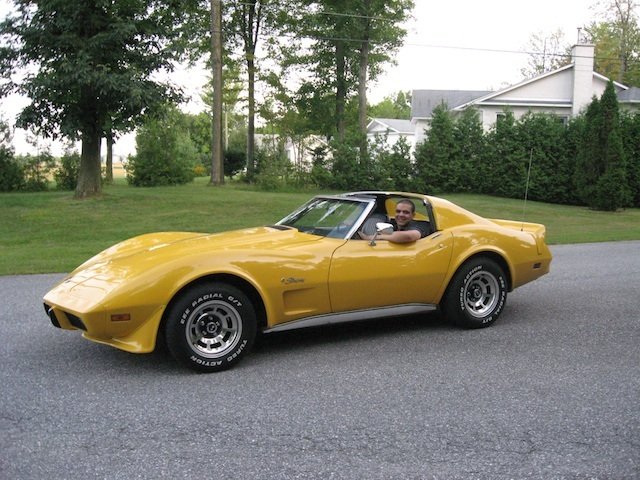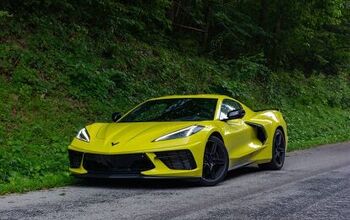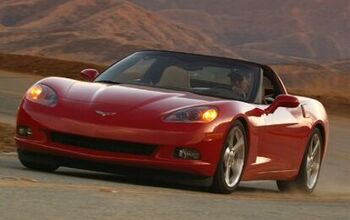Review: 1976 Chevrolet Corvette

For accountants, there are two certainties: golf and taxes. Together, both are tedious enough to make me want death. Unfortunately, I knew I’d be hearing a lot about both of these moribund subjects at our firm golf tournament. I was in the parking lot that morning, praying to the heavens for divine intervention when I heard my boss’ 1976 Corvette growling and lazily pulling up. As soon as I saw the ‘Vette, I decided to cash in the goodwill I’d earned by working 300 hours of overtime between November and March. “Fifteen minutes – no more,” he said. Score.
As we sat down for the drive, my boss smiled. He knew what was coming. I turned the ignition; the car sputtered lamely. “This always happens when I drive cars that are older than me,” I said. I primed it with a flick of the gas and the 305 V8 rumbled to life. T-Top off, we hit the country roads near the course.
The car’s age was immediately apparent. The brakes were spongy and non-linear, the pedal travel was maddening and the stock automatic only had three speeds. The car’s handling managed to somehow both be soft, yet twitchy over destitute farm roads. By far the worst thing was the skinny steering wheel. Though it was relatively linear, the steering offered about 20 degrees of play before engaging in earnest, and when it did, it gave me an upper body workout worthy of P90X. Gripping the skinny tiller, and then making the Herculean effort to rotate it, I wondered if power steering should trump sliced bread as the world’s greatest invention.
I struggled to find a basis for comparison. The Corvette was so raw, so unrefined, so different from anything I’d driven. Though it was a “luxury” car in its day, I could never treat it as such. Every change of direction had to be planned in advance, lest the understeer or snap oversteer take over with such non-linear brakes. Every turn of the steering required a rest until the next. This thing wasn’t even close to a luxury car, it was a motorcycle on four wheels. Even the straight pipes and their thunderous burble reminded me of a bike.
As we bombed it down the country roads, I wasn’t taken back to a scene from Bullit, or 2 Fast Too Furious. The only thing I could think of was the opening scene in Lawrence of Arabia. The one where Peter O’Toole pushes his bike to the limit, swallowing the country road ahead of him, approaching death so closely just to see if he could still feel alive.
“This is all really cheesy,” I said to my boss. “Yeah, but it’s a kind of cheesy I like,” he replied.
It all felt so ancient, belonging to a time when Americans loved the open road. Before drivers learned to delegate 90 percent of a car’s decisions to a computer. A time when cars were so fun, and new, and cool, and awesome that just hitting a piece of strip was an event in and of itself. And the Stingtay was near the top of the pantheon, as far as perfect cars to devour the Interstate: more adventurous and accessible than a Cadillac of the same vintage, and more athletic than a Chevy Impala.
As cars became more insular, and the “Sunday drive” became a thing of the past, they stopped making Vettes like this one. But this Vette didn’t just take me through country roads, it brought me back to 1976. The 305 burbled, the sun shone and the road lay ahead of us. No speed traps, no ABS, no traction control. Just the Vette, my scared shitless Boss and I. A rare moment of automotive nirvana.
In the end, it didn’t really matter that the 305 could barely manage to produce wheelspin without power braking. And I hardly cared that the yellow Stinger was ridiculously phallic (it could probably arouse Bob Dole from the dead). Or that the seats were so old and cracked and offered so little lumbar support that I regretted not bringing my chiro along. Nope, none of that mattered.
Not having been alive when it rolled off the line, it was clear I couldn’t evaluate the Vette against its peers. All I knew was that I loved it. Was it because it was so different than the type of cars I grew up in, or was it because it was a bona fide good car? Out here on these country roads, as the miles piled up, the engine roared and I felt strangely at peace with myself, I’m not sure the answer really mattered.

Latest Car Reviews
Read moreLatest Product Reviews
Read moreRecent Comments
- W Conrad I'm not afraid of them, but they aren't needed for everyone or everywhere. Long haul and highway driving sure, but in the city, nope.
- Jalop1991 In a manner similar to PHEV being the correct answer, I declare RPVs to be the correct answer here.We're doing it with certain aircraft; why not with cars on the ground, using hardware and tools like Telsa's "FSD" or GM's "SuperCruise" as the base?Take the local Uber driver out of the car, and put him in a professional centralized environment from where he drives me around. The system and the individual car can have awareness as well as gates, but he's responsible for the driving.Put the tech into my car, and let me buy it as needed. I need someone else to drive me home; hit the button and voila, I've hired a driver for the moment. I don't want to drive 11 hours to my vacation spot; hire the remote pilot for that. When I get there, I have my car and he's still at his normal location, piloting cars for other people.The system would allow for driver rest period, like what's required for truckers, so I might end up with multiple people driving me to the coast. I don't care. And they don't have to be physically with me, therefore they can be way cheaper.Charge taxi-type per-mile rates. For long drives, offer per-trip rates. Offer subscriptions, including miles/hours. Whatever.(And for grins, dress the remote pilots all as Johnnie.)Start this out with big rigs. Take the trucker away from the long haul driving, and let him be there for emergencies and the short haul parts of the trip.And in a manner similar to PHEVs being discredited, I fully expect to be razzed for this brilliant idea (not unlike how Alan Kay wasn't recognized until many many years later for his Dynabook vision).
- B-BodyBuick84 Not afraid of AV's as I highly doubt they will ever be %100 viable for our roads. Stop-and-go downtown city or rush hour highway traffic? I can see that, but otherwise there's simply too many variables. Bad weather conditions, faded road lines or markings, reflective surfaces with glare, etc. There's also the issue of cultural norms. About a decade ago there was actually an online test called 'The Morality Machine' one could do online where you were in control of an AV and choose what action to take when a crash was inevitable. I think something like 2.5 million people across the world participated? For example, do you hit and most likely kill the elderly couple strolling across the crosswalk or crash the vehicle into a cement barrier and almost certainly cause the death of the vehicle occupants? What if it's a parent and child? In N. America 98% of people choose to hit the elderly couple and save themselves while in Asia, the exact opposite happened where 98% choose to hit the parent and child. Why? Cultural differences. Asia puts a lot of emphasis on respecting their elderly while N. America has a culture of 'save/ protect the children'. Are these AV's going to respect that culture? Is a VW Jetta or Buick Envision AV going to have different programming depending on whether it's sold in Canada or Taiwan? how's that going to effect legislation and legal battles when a crash inevitibly does happen? These are the true barriers to mass AV adoption, and in the 10 years since that test came out, there has been zero answers or progress on this matter. So no, I'm not afraid of AV's simply because with the exception of a few specific situations, most avenues are going to prove to be a dead-end for automakers.
- Mike Bradley Autonomous cars were developed in Silicon Valley. For new products there, the standard business plan is to put a barely-functioning product on the market right away and wait for the early-adopter customers to find the flaws. That's exactly what's happened. Detroit's plan is pretty much the opposite, but Detroit isn't developing this product. That's why dealers, for instance, haven't been trained in the cars.
- Dartman https://apnews.com/article/artificial-intelligence-fighter-jets-air-force-6a1100c96a73ca9b7f41cbd6a2753fdaAutonomous/Ai is here now. The question is implementation and acceptance.


































Comments
Join the conversation
Check this out, for people that think the 76 is the least desirable year, Found this on CorvetteBlogger.com. BTW, I love my 76, the last Stingray! Top Appreciation Models 2009 Year Make % Change Average Price 1976 T-Top 10% $10,800 1962 Roadster 9% $52,700 1963 Coupe 9% $54,500 1977 T-Top 9% $12,000 1957 Roadster 8% $64,800 1965 Roadster 8% $46,100 1960 Roadster 7% $50,400 1963 Roadster 7% $41,600 1964 Roadster 7% $38,200 1966 Coupe 7% $46,200 Quite surprisingly, we found the 1976 Corvette at the top of our appreciation chart at 10% followed by the 1977 model at 9%. Evidently what we are seeing is renewed interest in the last of the traditional C3 body style models prior to the C3 change to a ‘fast back’ body style with the 1978-1982 models. It is also interesting to note the 1976 and 1977 T-Tops are selling at approximately $10-$12,000 LESS than the C3 chrome bumper Corvettes with the same body silhouette.
Bought one of these new. If I remember correctly I paid $10,680. 4 speed with the T-Bar roof. So it would now be worth about the same which is a lot more than I can say for the Dodge Caravans I have been driving for the past 20 years. At the time the '76 was considered superior to the 73, 74 and 75 models. I certainly had no trouble with those if they were unmodified. For its time it was considered fast and had far more status (and sex appeal) that any European car, except for Aston Martins. However, the rear defog button was located down in the tunnel, the seats were awful, the car squeeked and it blew hot air constantly. Since it didn't have A.C. when it rained in the hot weather it was basically undriveaable due to the heat in the driver's compartment. The battery was behind the seats. Mine died once. As a safety feature the clutch had to be depressed to start the car. So I had to lay across the seats and work the clutch, gas, brake (my emergency brake was defective from the factory) with my hands while the seats were lowered over my back and the booster was run to the battery. Still, great times. Wish that I still had it. Unfortunately needed something more 'practical' so I traded it for a realy P.O.S. brand new '78 T-Bird.